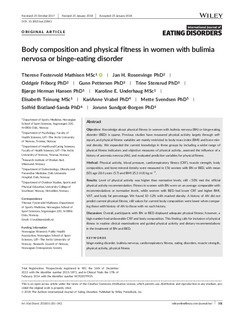| dc.contributor.author | Mathisen, Therese Fostervold | |
| dc.contributor.author | Rosenvinge, Jan H | |
| dc.contributor.author | Friborg, Oddgeir | |
| dc.contributor.author | Pettersen, Gunn | |
| dc.contributor.author | Stensrud, Trine | |
| dc.contributor.author | Hansen, Bjørge Hermann | |
| dc.contributor.author | Underhaug, Karoline | |
| dc.contributor.author | Teinung, Elisabeth | |
| dc.contributor.author | Vrabel, Kari-Anne | |
| dc.contributor.author | Svendsen, Mette | |
| dc.contributor.author | Bratland-Sanda, Solfrid | |
| dc.contributor.author | Sundgot-Borgen, Jorunn | |
| dc.date.accessioned | 2018-05-25T08:33:12Z | |
| dc.date.available | 2018-05-25T08:33:12Z | |
| dc.date.created | 2018-02-14T12:46:53Z | |
| dc.date.issued | 2018 | |
| dc.identifier.citation | International Journal of Eating Disorders. 2018;51:331–342 | nb_NO |
| dc.identifier.issn | 0276-3478 | |
| dc.identifier.uri | http://hdl.handle.net/11250/2499196 | |
| dc.description.abstract | Objective: Knowledge about physical fitness in women with bulimia nervosa (BN) or binge-eating disorder (BED) is sparse. Previous studies have measured physical activity largely through selfreport, and physical fitness variables are mainly restricted to body mass index (BMI) and bone mineral density. We expanded the current knowledge in these groups by including a wider range of physical fitness indicators and objective measures of physical activity, assessed the influence of a history of anorexia nervosa (AN), and evaluated predictive variables for physical fitness.
Method: Physical activity, blood pressure, cardiorespiratory fitness (CRF), muscle strength, body composition, and bone mineral density were measured in 156 women with BN or BED, with mean (SD) age 28.4 years (5.7) and BMI 25.3 (4.8) kg m22.
Results: Level of physical activity was higher than normative levels, still <50% met the official physical activity recommendation. Fitness in women with BN were on an average comparable with recommendations or normative levels, while women with BED had lower CRF and higher BMI, VAT, and body fat percentage. We found 10–12% with masked obesity. A history of AN did not predict current physical fitness, still values for current body composition were lower when comparing those with history of AN to those with no such history.
Discussion: Overall, participants with BN or BED displayed adequate physical fitness; however, a high number had unfavorable CRF and body composition. This finding calls for inclusion of physical fitness in routine clinical examinations and guided physical activity and dietary recommendations in the treatment of BN and BED. | nb_NO |
| dc.language.iso | eng | nb_NO |
| dc.rights | Navngivelse 4.0 Internasjonal | * |
| dc.rights.uri | http://creativecommons.org/licenses/by/4.0/deed.no | * |
| dc.title | Body composition and physical fitness in women with bulimia nervosa or binge-eating disorder | nb_NO |
| dc.title.alternative | Body composition and physical fitness in women with bulimia nervosa or binge-eating disorder. | nb_NO |
| dc.type | Journal article | nb_NO |
| dc.type | Peer reviewed | nb_NO |
| dc.description.version | publishedVersion | nb_NO |
| dc.source.pagenumber | 331-342 | nb_NO |
| dc.source.journal | International Journal of Eating Disorders | nb_NO |
| dc.identifier.doi | 10.1002/eat.22841 | |
| dc.identifier.cristin | 1565112 | |
| cristin.unitcode | 222,59,4,0 | |
| cristin.unitname | Institutt for friluftsliv, idrett og kroppsøving | |
| cristin.ispublished | true | |
| cristin.fulltext | original | |
| cristin.qualitycode | 2 | |

